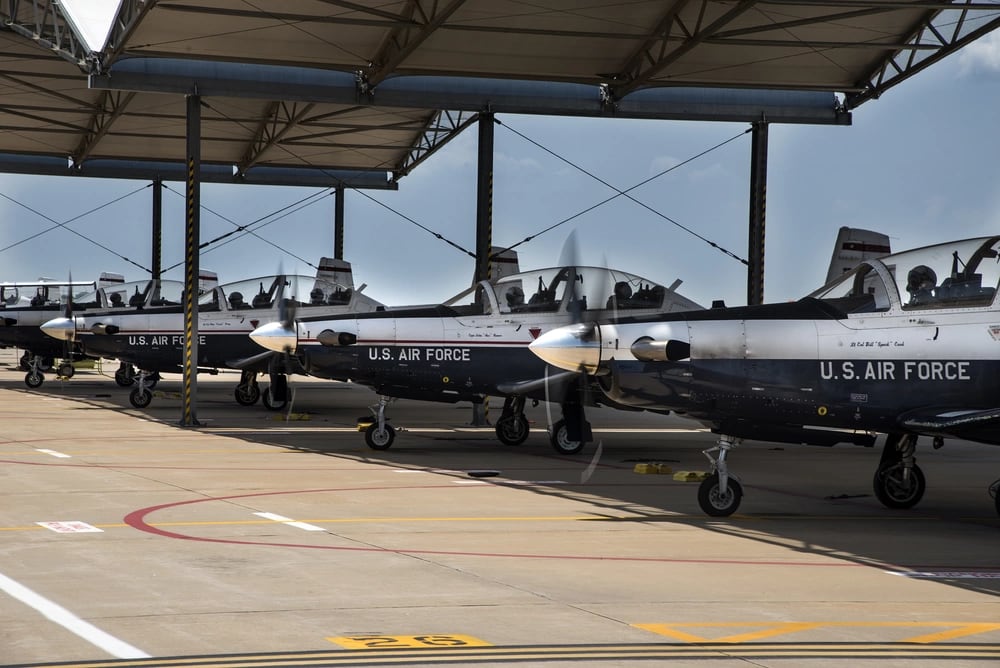A tornado that struck southwest Ohio early Wednesday damaged several buildings at Wright-Patterson Air Force Base, including a complex of aircraft-restoration hangars where work has been underway on the only surviving B-17D Flying Fortress.
No one was injured in the tornado, which hit around 4:30 a.m. and lasted four minutes, the National Weather Service said. The storm was among a string of tornados that hit southwest and central Ohio Wednesday. It was classified as an EF1, the second-lowest rating on a six-level scale, with gust speeds between 86 and 110 mph.
Winds measuring up to 100 mph ripped off shingles and siding and blew out windows of several buildings on base, including a World War II-era hangar complex where the National Museum of the U.S. Air Force has several restoration projects underway.
RELATED

Damage was isolated to the southern side of Wright-Patterson. Photos posted by the base illustrate some of the impact that appeared to most heavily affect the hangars, including bending massive doors.
“Our initial focus right now is on safety and damage assessment,” Col. Travis Pond, 88th Air Base Wing and installation commander, said in a news release Wednesday. “I can’t speak highly enough about our security forces, fire department and civil engineer airmen for their quick response and hard work to assess damage and determine a path forward for restoring operations as quickly as possible.”
The museum owns three connected hangars, known as Hangar 4, which house several restoration projects including a B-17 nicknamed “The Swoose,” which flew on the first U.S. combat mission in the Philippines within hours of the attack on Pearl Harbor on Dec. 7, 1941.
No high-dollar artifacts were damaged, including the B-17, which sat in a hangar with broken windows, said museum spokesperson Ty Greenlees. Debris poked through fabric used on a Bleriot XI, a wood-framed French aircraft undergoing work in the hangar that sustained the heaviest damage, but Greenlees said the aircraft was repairable.
“Just some bumps and scratches on a few things,” Greenlees said.
Crews were still assessing the damage to the base on Friday, and Greenlees said workers were sealing broken windows so heat could be turned back on. Artifacts could temporarily move to other hangars, he said.
The carcasses of three aircraft — an F-104 Starfighter, a T-33 Shooting Star jet trainer and a A-26 Intruder, a bomber and attack aircraft used during WWII — that were sitting outside the hangars awaiting disposal were also “tossed around quite a bit,” Greenlees said.
The U.S. military and lawmakers have increasingly sounded alarm bells about the problems severe weather has caused to military bases at home and abroad, including its ability to erode national security. In October 2018, Hurricane Michael, a Category 5 storm, devastated Tyndall Air Force Base, Florida, which is now in the midst of a multibillion-dollar, yearslong rebuild effort. Tyndall, previously home to F-22 Raptors that moved to Joint Base Langley Eustis, Virginia, is now set to fly three F-35A Lightning squadrons that will comprise the 325th Fighter Wing.
More than 30,000 personnel work at Wright-Patterson, home to Air Force Material Command headquarters, the Air Force Research Laboratory, the National Air and Space Intelligence Center and the 445th Airlift Wing, among other operations.
None of the nine C-17 Globemaster III airlifters owned by the 445th AW, a Reserve unit, were damaged in the storm, wing spokesperson Amanda Dick told Air Force Times.
Courtney Mabeus-Brown is the senior reporter at Air Force Times. She is an award-winning journalist who previously covered the military for Navy Times and The Virginian-Pilot in Norfolk, Va., where she first set foot on an aircraft carrier. Her work has also appeared in The New York Times, The Washington Post, Foreign Policy and more.





